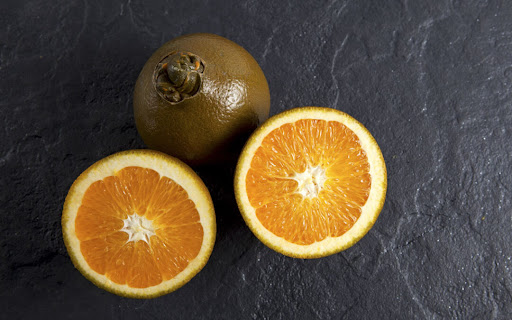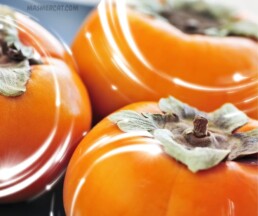Divine Fire Fruit: The Persimmon
A very familiar name in our shopping basket during the autumn-winter season, also called Sharoni (Triumph), Persimon, Kaki, or Palo Santo.
We’ve decided to dedicate this space to delve a little into its history and how it has earned a special place in consumers’ preferences.
Where Did It Originate?
Divine Fire Fruit: The PersimLike several fruits we’ve discussed in our blog, its origin lies in Asia—specifically China and Japan. Its scientific name is "Diospyros kaki", which means "fruit of the divine fire." In Japan, it is associated with longevity and good fortune, and in many cultures, it symbolizes perseverance and inner strength.
Beyond its symbolism, it is a fruit with rich traditions, sweetness, and numerous health benefits.
In Spain, it was introduced in the 18th century and was warmly received, eventually earning a strong foothold in the fields of Spanish farmers. This is particularly true in the Ribera Alta region of the Valencian Community, where it has flourished with great success and is now the second-largest persimmon-producing region in the world. This effort resulted in the creation of the "Kaki Ribera del Xúquer" Designation of Origin, which we will discuss in greater detail in this article.
Today, Spain, along with Italy, are the largest producers in the European region.
A Unique Flavor?
This is a topic of much discussion among consumers, as persimmons can sometimes be slightly bitter in certain varieties. This characteristic is due to tannins, which give the fruit its astringent taste, leading to classifications as astringent or non-astringent varieties.
Some astringent varieties include: Rojo Brillante, Eureka, Hachiya, and Koushu-Hyakume, which must be eaten when very ripe to avoid astringency. At this stage, the fruit’s texture becomes so soft that it can even be eaten with a spoon. In the case of the Rojo Brillante variety, once the astringency is removed, it is known as Persimon, a protected brand name. After post-harvest treatment, it retains its firmness and develops a sweeter taste.
Non-astringent varieties include: Jiro, Sharon, Honan Red, and Fuyu, which naturally mature until the fruit becomes softer and sweeter.
However, the fruit's soft flesh posed a challenge for commercialization, leading to the search for alternative ripening techniques to produce a sweet yet firm-textured fruit.
With the support of the Valencia Agricultural Research Center and based on the Rojo Brillante variety, a fruit oxidation process was developed, resulting in the Kaki Ribera del Xúquer Designation of Origin mentioned earlier. This product is characterized by firm consistency, an intense orange skin and flesh, a good size, and a sweet flavor.
This innovation has been a great success, enabling easier handling and access to international markets, significantly expanding over the last twenty years.
What Are Its Health Benefits?
The persimmon harvest season in Spain runs from October to January, coinciding with colder weather and the onset of colds and flu. Maintaining a strong immune system is crucial during this time. Nature provides us with many fruits to strengthen our immune systems, from delicious citrus fruits to flavorful berries like persimmons, which offer numerous nutrients.
It contains:
- Antioxidants– Fight free radicals, thereby boosting the immune system.
- Calcium– Strengthens bones.
- Potassium– Improves heart health, blood pressure, and arteries.
- Vitamin A - Enhances eye health.
- Vitamin C - Improves iron absorption and skin appearance.
- Flavonoids - Beta-carotenes that boost the immune system.
- Fiber – Improves digestion and regulates intestinal transit, as soluble fiber retains water and reduces cholesterol levels.
These nutrients make persimmons an excellent addition to your diet, especially during the autumn and winter seasons when they are at their peak. We encourage you to maintain a balanced and healthy diet along with regular exercise. We encourage you to maintain a balanced and healthy diet, as well as a regular exercise routine.
We invite you to explore our products.
Navel Cara - Cara orange, highly appreciated by the Nordic people
A variety of the navel orange, since its introduction in the 1970s, has gradually earned a special place among Nordic tastes, due to its sweetness and low acidity.
One of our clients in Germany said regarding the taste of Cara Cara Orange: “Mega Geil… ist SPITZE”, which means it’s the best. That’s why we have decided to dedicate this publication to this variety, where we will focus on its origin and the characteristics that make it so appreciated.
Originating in the 70s
The Cara Cara Orange, scientifically known as Citrus sinensis, is a variety of orange that originated in Venezuela. Its name “Cara Cara” comes from the Cara Cara plantation, where it was first discovered in the 1970s. But it wasn’t until it was cultivated in California, USA, that it began to be known and appreciated. It has gained popularity worldwide due to its sweet and aromatic flavor, lower acidity, as well as its high nutrient and antioxidant content.
A citrus variety that, since its introduction to the Spanish market in the 70s, has gradually gained a place in preferences in Nordic countries.
From the Navel family, what sets it apart?
What makes the Cara Cara Orange stand out among other varieties is its internal color. While most oranges have an orange pulp, the Cara Cara surprises with a pinkish hue. This distinctive tone is due to the presence of lycopene, the same antioxidant responsible for the red color in tomatoes and watermelons. It could easily be mistaken for a grapefruit; however, its sweet and acidic flavor gives it away. Its tender and juicy pulp makes it an irresistible bite.
The pleasure of enjoying a Cara Cara Orange goes beyond its delicious taste. This variety is loaded with health benefits. Like most oranges, its vitamin C content strengthens the immune system, while its fiber contributes to digestive health. Additionally, the presence of antioxidants such as lycopene and vitamin A helps combat free radicals, promoting healthy skin and slower cellular aging.

A Touch of Freshness and Flavor.
In Mediterranean cuisine, known for its fresh ingredients, the Cara Cara Orange has found its place of honor. From salads to main dishes, this orange has been creatively integrated into various recipes, bringing its sweetness and unique citrusy touch.
The Cara Cara Orange is characterized by its durability in storage; the production season runs from late November to late April. It is smaller in size compared to other varieties.
It is one of the varieties that is most often exported to Nordic countries, bringing its citrusy touch in the winter season and gaining space for its versatility in international cuisine, available for consumption in the Valencian fields. Discover the pleasure of this Cara Cara Orange and bring Mediterranean freshness to your table!
Autor: Selene.
Chocolate Navel Orange: From being an almost forgotten variety in Spain to being recovered as a gourmet fruit
From the navel orange family, the Chocolate Navel Orange stands as a variety that has conquered palates with its exquisite flavor and distinctive aroma.
Result of a natural mutation of orange trees, it has been recovered by some farmers in the Mediterranean region in the Valencian Community, in the town of Picassent (L’Horta Sur) and has made a place for itself among the most demanding palates.
The Chocolate Navel Orange, scientifically called Sinensis Citrus, stands out for its peculiar brown color resulting from the permanence of its green and orange pigments once ripe, in addition to a high degree of sweetness, reaching 12 brix, which leads it to be considered the sweetest of the navels, with a low acidity flavor. Among other characteristics worth highlighting is the high percentage of juice, its fine, shiny, soft and grainy skin, which gives way to easy peeling, from which a combined aroma of fruity and floral notes is released. Its size is medium to large within the Navel family, with a uniform rounded shape.

The perfect balance between acidity and sweetness makes this orange a versatile ingredient for a wide range of culinary preparations.
From jams and desserts to salad dressings and juice, Navel Chocolate Orange provides a distinctive touch that elevates any dish to another gastronomic level, as well as its natural consumption, the fruit itself, is already a pleasure.
Currently it is not easy to find in the local market, since it is grown only by a few Valencian farmers, who are betting on this ancient variety for export. But it has made a place in the palates of some countries worldwide, Holland was the first to import it in 2021 and expand it to some countries in Europe. It is currently considered a highly profitable product, due to its high price, driven by product scarcity, in addition to its low production costs compared to other citrus fruits affected by more pests, giving it a greater profit margin.
Orange also offers a number of health benefits. Rich in vitamin C, antioxidants and fiber, this fruit not only delights the palate, but also contributes to general well-being. Vitamin C strengthens the immune system, antioxidants fight free radicals and fiber promotes digestion, making Chocolate Navel Orange a delicious and nutritious option.

Chocolate Navel Orange is not only a delight for the senses, but also a nutritious addition to a balanced diet. Available in the winter season and early spring.
Its fascinating origin, its peculiar characteristics and its health benefits make it a fruit that will give that cheerful and tasty touch to our winter menu.
Autor: Selene.
Tangerines vs. Clementines: Differences, Origins, and Benefits
A little orange treasure that has illuminated our days and nourished our bodies throughout history. On this journey through the delicious world of tangerines, we will explore their origins, unravel the mystery behind their relationship with clementines and highlight the properties and benefits that make this fruit a true gift from nature.
A journey through time: The story of the tangerine
The tangerine, belonging to the citrus family, has its roots in Southeast Asia. It is believed to have been first cultivated in China thousands of years ago and, over time, has become one of the most prized fruits in the world. Its name derives from the bright color of the clothing of ancient Chinese officials, known as “mandarin”.
The expansion of the Silk Road played a crucial role in the spread of the tengerine throughout Asia, Europe and finally America. Today, it is grown in diverse regions, from the sunny fields of California to the lush orchards of Spain.
Tangerines vs. Clementines: What is the difference?
Tangerines and clementines are often mentioned interchangeably, but are they really the same thing? The answer is yes and no. Both belong to the group of citrus fruits, but clementines are a specific variety of tangerines. The distinction may be subtle, but citrus connoisseurs may notice differences in flavor and size. Clementines tend to be smaller, sweeter, and easier to peel than mandarins in general.

Varieties of Tangerines and Clementines
As mentioned above, clementine is a variety of tangerine, but its popularity and distinctive characteristics deserve a specific mention. It is known for its sweet flavor, easy peeling, and smaller size. Some of the best known varieties are:
Clemenules: This clementine variety deserves special recognition. Originally from Spain, Clemenules are famous for being juicy, easy to peel and with a perfect balance between sweet and sour. Its harvest season in winter makes it a perfect delight to brighten the coldest days.
Fine Clementine: This clementine is another gem that stands out for its sweetness and softness. The skin is thin and easy to remove, revealing juicy segments full of flavor.
Nules Clementine: Originally from Spain, this variety is similar to Clemenules in terms of flavor and ease of peeling. Its presence in the markets is mainly concentrated during the winter season.
Other varieties of tangerines: In addition to clementines, there are a variety of tangerines, each with its own distinctive characteristics. Some of the best known include:
Satsuma Tangerine: Native to Japan, the Satsuma tangerine is easily recognizable by its loose skin and sweet, juicy flavor.
Dancy Tangerine: With its deep red color and sweet and sour flavor, Dancy is a tangerine that is enjoyed during the winter season.
Murcott Tangerine: Conocida por su piel delgada y su sabor distintivo, la mandarina Murcott es popular en climas cálidos y se cosecha principalmente en primavera.
The world of mandarins and clementines is diverse and delicious. Each variety has its unique charm, but Clemenules stands out as a gem among clementines, offering a culinary experience worth savoring. Let’s enjoy the variety and exquisiteness of these wonderful citrus fruits!
The properties that make the tangerine shine
Behind its bright orange skin and juicy flavor, the tangerine harbors a wealth of beneficial health properties. Here are some reasons why this little fruit deserves a prominent place in your diet:
Vitamin C: Tangerine is a powerhouse of vitamin C, a key antioxidant that strengthens the immune system and promotes skin health.
Fiber: Rich in fiber, tangerine helps maintain a healthy digestive system and may contribute to weight loss by providing a feeling of satiety.
Antioxidant:The antioxidants present in tangerine help fight free radical damage, protecting our cells and promoting overall health.
Hydration: With a high water content, tangerine is a great option for staying hydrated, especially in hot weather.

Benefits of regular consumption of tangerines
Incorporating tangerines into your diet can offer a number of long-term health benefits. Some of these include:
Cardiovascular health: Tangerine can help reduce cholesterol levels and improve heart health.
Control of blood pressure: Nutrients like potassium in tangerines can help maintain healthy blood pressure levels.
Weightloss: ts fiber and low calorie content make tangerines an ideal snack for those looking to lose weight.
Eye health: The presence of vitamin A in tangerines is beneficial for vision and eye health in general.
These citrus fruits are not only delicious fruits, but also an invaluable source of essential nutrients. From its humble beginnings in China to its global status as a healthy snack, it has left a lasting mark on food history. The next time you enjoy this little orange wonder, remember that you are savoring not only its exquisite flavor, but also centuries of history and health concentrated in each juicy segment. Enjoy the tangerines!
Autor: Selene.




